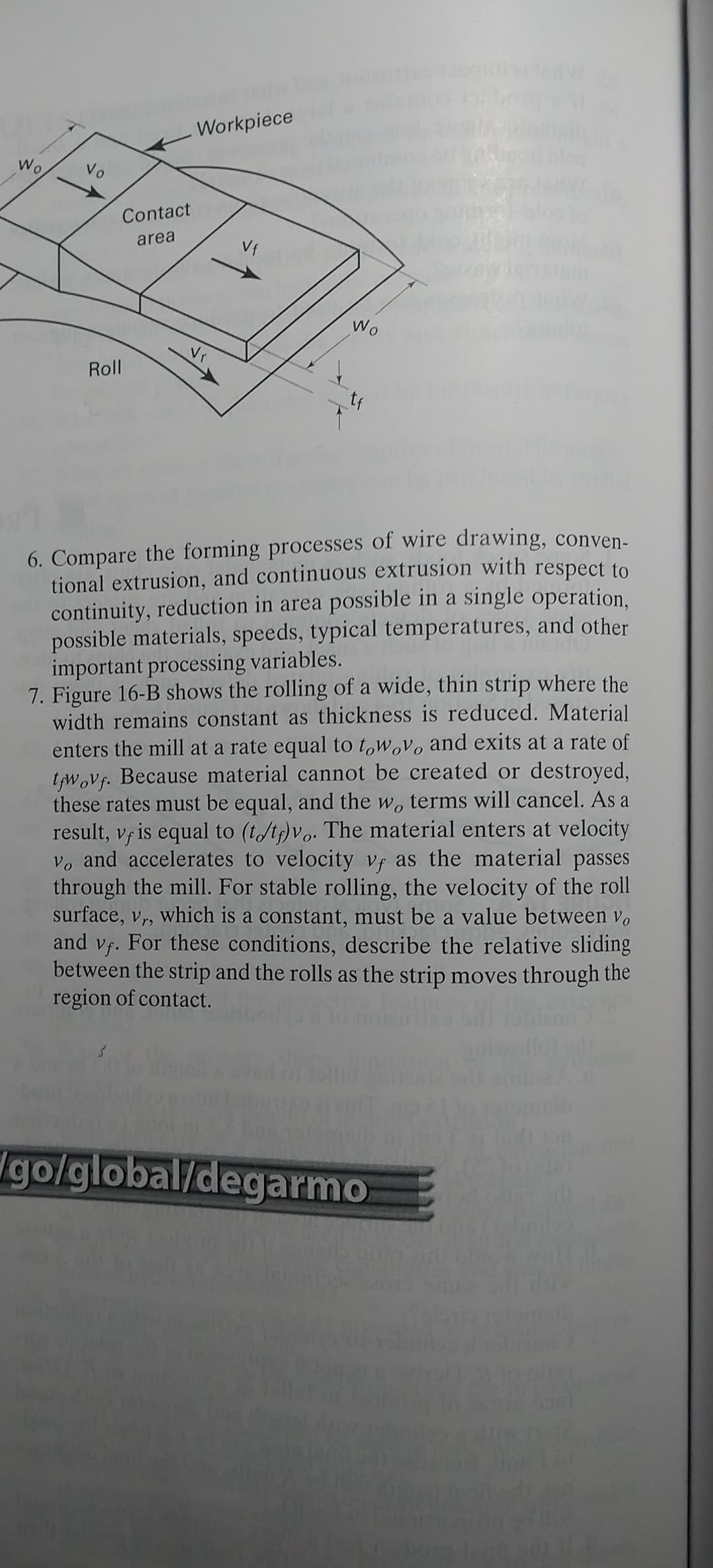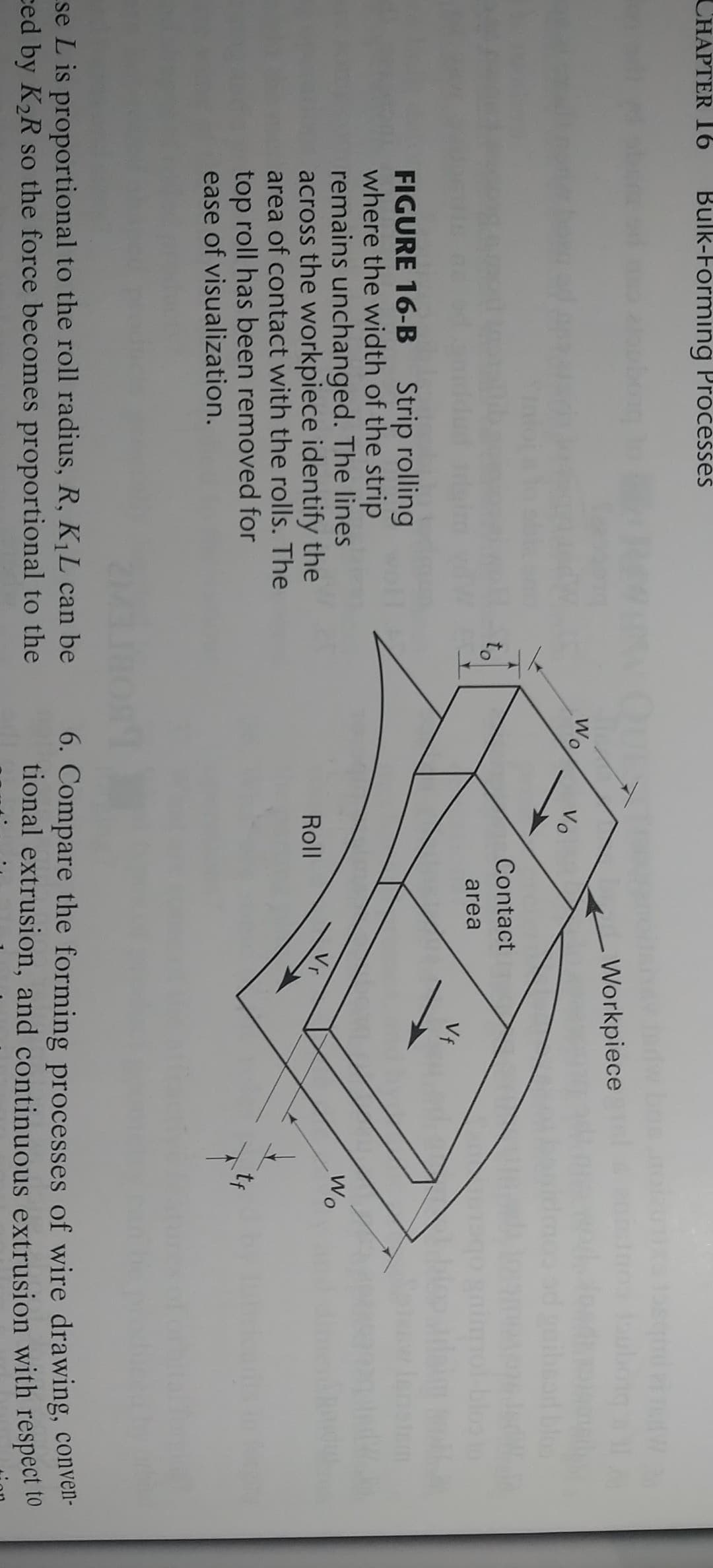6. Compare the forming processes of wire drawing, conven- tional extrusion, and continuous extrusion with respect to continuity, reduction in area possible in a single operation, possible materials, speeds, typical temperatures, and other important processing variables.
6. Compare the forming processes of wire drawing, conven- tional extrusion, and continuous extrusion with respect to continuity, reduction in area possible in a single operation, possible materials, speeds, typical temperatures, and other important processing variables.
Elements Of Electromagnetics
7th Edition
ISBN:9780190698614
Author:Sadiku, Matthew N. O.
Publisher:Sadiku, Matthew N. O.
ChapterMA: Math Assessment
Section: Chapter Questions
Problem 1.1MA
Related questions
Question
This problem from Degarmo's textbook is our report.

Transcribed Image Text:Workpiece
Wo
Vo
Contact
area
Vf
Wo
Roll
6. Compare the forming processes of wire drawing, conven-
tional extrusion, and continuous extrusion with respect fo
continuity, reduction in area possible in a single operation,
possible materials, speeds, typical temperatures, and other
important processing variables.
7. Figure 16-B shows the rolling of a wide, thin strip where the
width remains constant as thickness is reduced. Material
enters the mill at a rate equal to towovo and exits at a rate of
tjw,Vf. Because material cannot be created or destroyed,
these rates must be equal, and the w. terms will cancel. As a
result, vf is equal to (t/tf)vo. The material enters at velocity
Vo and accelerates to velocity vf as the material passes
through the mill. For stable rolling, the velocity of the roll
surface, v,, which is a constant, must be a value between v,
and vf. For these conditions, describe the relative sliding
between the strip and the rolls as the strip moves through the
region of contact.
go/global/degarmo

Transcribed Image Text:Bulk-Forming Processes
CHAPTER I6
Workpiece
Wo
Vo
Contact
to
area
Vf
Strip rolling
FIGURE 16-B
where the width of the strip
remains unchanged. The lines
across the workpiece identify the
area of contact with the rolls. The
top roll has been removed for
ease of visualization.
Wo
Vr
Roll
tf
se L is proportional to the roll radius, R, K1L can be
ced by K2R so the force becomes proportional to the
6. Compare the forming processes of wire drawing, conven-
tional extrusion, and continuous extrusion with respect to
Expert Solution
This question has been solved!
Explore an expertly crafted, step-by-step solution for a thorough understanding of key concepts.
This is a popular solution!
Trending now
This is a popular solution!
Step by step
Solved in 2 steps

Knowledge Booster
Learn more about
Need a deep-dive on the concept behind this application? Look no further. Learn more about this topic, mechanical-engineering and related others by exploring similar questions and additional content below.Recommended textbooks for you

Elements Of Electromagnetics
Mechanical Engineering
ISBN:
9780190698614
Author:
Sadiku, Matthew N. O.
Publisher:
Oxford University Press

Mechanics of Materials (10th Edition)
Mechanical Engineering
ISBN:
9780134319650
Author:
Russell C. Hibbeler
Publisher:
PEARSON

Thermodynamics: An Engineering Approach
Mechanical Engineering
ISBN:
9781259822674
Author:
Yunus A. Cengel Dr., Michael A. Boles
Publisher:
McGraw-Hill Education

Elements Of Electromagnetics
Mechanical Engineering
ISBN:
9780190698614
Author:
Sadiku, Matthew N. O.
Publisher:
Oxford University Press

Mechanics of Materials (10th Edition)
Mechanical Engineering
ISBN:
9780134319650
Author:
Russell C. Hibbeler
Publisher:
PEARSON

Thermodynamics: An Engineering Approach
Mechanical Engineering
ISBN:
9781259822674
Author:
Yunus A. Cengel Dr., Michael A. Boles
Publisher:
McGraw-Hill Education

Control Systems Engineering
Mechanical Engineering
ISBN:
9781118170519
Author:
Norman S. Nise
Publisher:
WILEY

Mechanics of Materials (MindTap Course List)
Mechanical Engineering
ISBN:
9781337093347
Author:
Barry J. Goodno, James M. Gere
Publisher:
Cengage Learning

Engineering Mechanics: Statics
Mechanical Engineering
ISBN:
9781118807330
Author:
James L. Meriam, L. G. Kraige, J. N. Bolton
Publisher:
WILEY